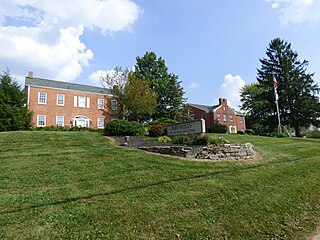
Greenhills is a village in Hamilton County, Ohio, United States. The population was 3,741 at the 2020 census. A planned community, it was established by the United States government during the Great Depression. Most of the village is a National Historic Landmark for its history as a planned modernist community.

The William Edwards Farmhouse is a historic residence near Cincinnati in the village of Newtown, Ohio, United States. One of the area's leading early farmhouses, it has been designated a historic site.

The Harrison–Landers House was a historic Federal-style residence near the village of Newtown in Hamilton County, Ohio, United States. Built in the first quarter of the 19th century, it served a range of residential and commercial purposes throughout its obscure history, but enough of its history was known to permit its designation as a historic site in the 1970s.

The Thomas Select School is a historic log building in rural Butler County, Ohio, United States. Constructed in 1810, the building has seen numerous uses, ranging from church to school to house. It has been named a historic site.

The Arnold Homestead is a historic homestead in the city of Huber Heights, a suburb of Dayton, Ohio, United States. Formed at the turn of the nineteenth century, it centers on an 1830s farmhouse that was built for an immigrant family from Virginia.
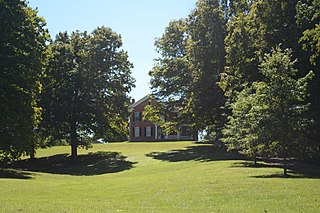
John Artz Farmhouse is a historic building located at 5125 Duffy Road Berne, Ohio near Lancaster.

The Kennedy Farm is a National Historic Landmark property on Chestnut Grove Road in rural southern Washington County, Maryland. It is notable as the place where the radical abolitionist John Brown planned and began his raid on Harpers Ferry, Virginia, in 1859. Also known as the John Brown Raid Headquarters and Kennedy Farmhouse, the log, stone, and brick building has been restored to its appearance at the time of the raid. The farm is now owned by a preservation nonprofit.

The Insco Apartments is a historic apartment building in downtown Dayton, Ohio, United States. It was designed by Charles Insco Williams, a native of Dayton, and constructed in 1894. Williams designed the structure after an apartment hotel that he had seen on Fifth Avenue in New York City; he did not copy the design slavishly, but many of the architectural themes present in the Insco Apartments were derived ultimately from the unspecified New York City apartment building.

The Church of Our Saviour is a historic Episcopal parish in the village of Mechanicsburg, Ohio, United States. Founded in the 1890s, it is one of the youngest congregations in the village, but its Gothic Revival-style church building that was constructed soon after the parish's creation has been named a historic site.

The H.E. Fledderjohann Property is a complex of five historic buildings in the village of New Knoxville, Ohio, United States. Three of these structures — a house, a doctor's office, and a standalone kitchen building — were owned and used by Fledderjohann, a prominent New Knoxville physician in the late nineteenth and early twentieth centuries.
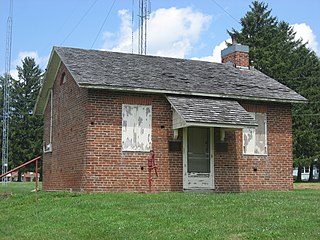
The Studabaker-Scott House and Beehive School are two historic buildings near the city of Greenville in Darke County, Ohio, United States. Located along State Route 49 south of the city, both are unusually well-preserved remnants of the architecture of the middle third of the 19th century.

The Wallischeck Homestead is a historic group of farm buildings in southwestern Mercer County, Ohio, United States. The family of Philo Wallischeck, all natives of the Grand Duchy of Baden, settled on the site in 1855. For their first ten years, they lived in a log cabin along the road; this arrangement ended when Philo bought a substantially larger area of land in 1866. Starting in that year and continuing until 1880, the family erected a complex of buildings that survive, virtually unchanged, into the present day.

Applethorpe Farm is a historic farmstead in northeastern Ross County, Ohio, United States. Located along Whissler Road north of the unincorporated community of Hallsville, it was established by the family of John Buchwalter in the early years of the nineteenth century. Among the region's earliest settlers, the Buchwalters erected a large log building soon after taking possession of the property. As the years passed, the farm acquired the name of "Applethorpe" because its grounds included the first apple orchard in Ross County.

The Millen House is a historic residence on the campus of Indiana University in Bloomington, Indiana, United States. Built by an early farmer, it is one of Bloomington's oldest houses, and it has been named a historic landmark.
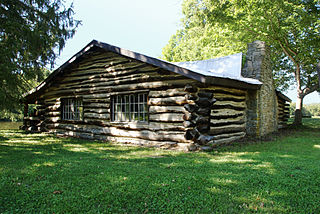
The Pfarr Log House was a log cabin located in an isolated valley near the village of Milford in rural Clermont County, Ohio, United States. Built in the early nineteenth century, it provided a pivotal representation of the area's earliest built environment, and it has been named a historic site. This cabin was known primarily as a property of the Pfarr family because it was purchased by George Pfarr in late 1840 as part of a 21-acre homestead, and it remained in the Pfarr family until it was sold to Jim Wiederhold in 1976. George, a butcher and farmer, immigrated from Bavaria with his wife and three children, and the property was actively farmed until the 1960s by his children and grandchildren. Current status unknown, but it is no longer standing in its original location next to Shayler Run creek.

The Old Meigs County Courthouse is a historic former government building in the small community of Chester, Ohio, United States. Erected in the early nineteenth century, the courthouse served multiple purposes for the surrounding community in its early years, but it operated as a courthouse for less than twenty years before being abandoned in favor of another courthouse in another community. Following a restoration in the 1950s, it was designated a historic site in the 1970s along with an adjacent school; the two buildings are operated together as a museum. It is Ohio's oldest extant building constructed as a courthouse.

The Lionville Historic District is a national historic district that is located in Uwchlan Township, Chester County, Pennsylvania, United States.

The Jamestown Opera House is a historic government building and community center in the village of Jamestown, Ohio, United States. It has been named a historic site because of its well-preserved architecture. Besides serving as a theater, the opera house has functioned as the community's village hall, its fire station, its post office, and its library.

The Mercer Log House is a large log cabin in the city of Fairborn, Ohio, United States. Home to the city's first settlers and changed very little since their time, it is one of Ohio's best preserved log cabins from the settlement period, and it has been named a historic site.
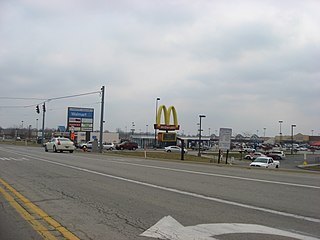
The William Burnett House was a historic farmhouse located near the city of Washington Court House in Fayette County, Ohio, United States. Constructed in the nineteenth century, it was once a masterpiece of multiple architectural styles, and it was designated a historic site because of its architectural distinction.






















